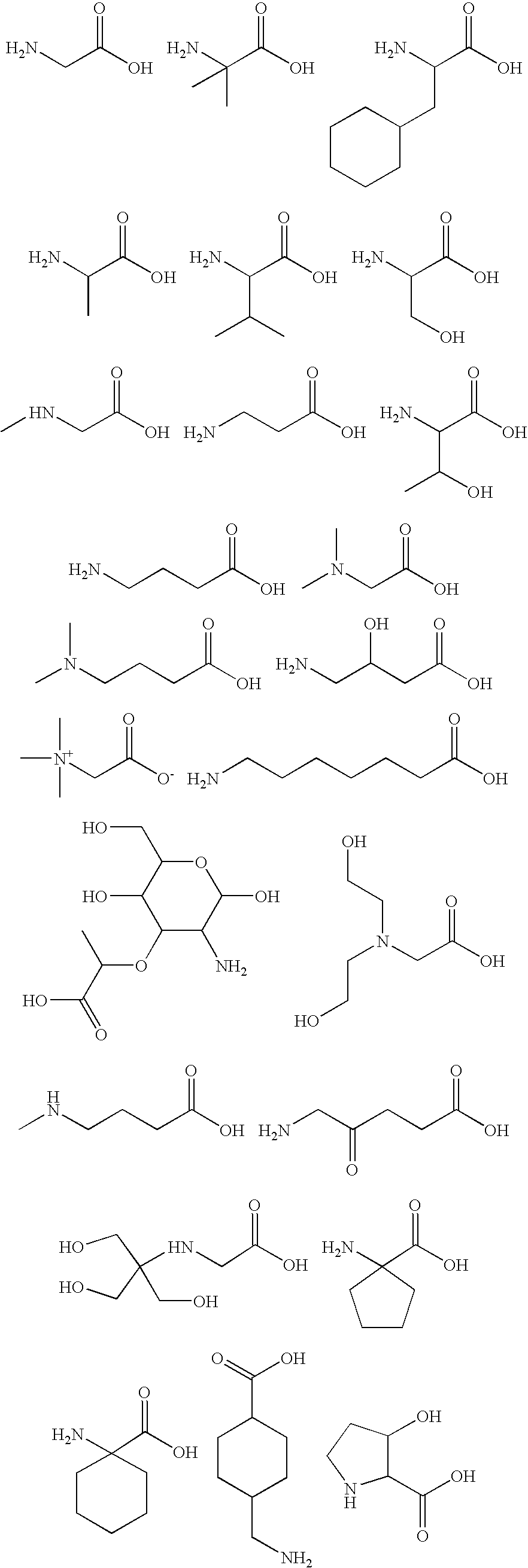Image recording material, planographic printing plate precursor, and planographic printing method using the same
a planographic printing plate and recording material technology, applied in the field of image recording materials, can solve the problems of photopolymerization reaction, difficult to achieve a photopolymerizable composition of stable quality, and the rapid decrease of the active radical generation capacity of the photopolymerization initiator with the decrease of the photoexcitation energy
- Summary
- Abstract
- Description
- Claims
- Application Information
AI Technical Summary
Benefits of technology
Problems solved by technology
Method used
Image
Examples
example a
Examples A1 to A5
Making of Support
[0557] A plate of JIA A 1050 aluminum having a thickness of 0.24 mm and a width of 1030 mm was continuously subjected to the following treatment processs (A) to (j). After each process and water washing, liquids were removed by a nip roller.
[0558] (a) Mechanical Surface Roughening Treatment
[0559] Using a mechanical surface roughening apparatus, the aluminum plate was mechanically surface roughened with rotating nylon brush rollers while a suspension of an abrasive material (pumice) had a specific gravity of 1.12 in water as an abrasive slurry supplied to the aluminum plate surface. The abrasive material had an average particle diameter of 40 to 45 μm, and a maximum diameter of 200 μm. The nylon brushes were made of nylon-6, 10 and had a bristle length of 50 mm and a bristle diameter of 0.3 mm. Three rotating brush rollers were used, each of which composed of a perforated stainless-steel cylinder having a diameter of 300 mm and bundles of such ny...
examples a5 to a14
[0598] The image recording layer coating solution (2) consisted of the following ingredients was applied with a wire bar to the aluminum support [2] made as described above. Thereafter, the coating was dried in an oven at 100° C. for 60 seconds to form an image recording layer in a dry coating amount of 1.3 g / m2.
Binder polymer [component (A), compound listed in Table]0.162 gPolymerization initiator [component (C), compound listed0.160 gin Table]Infrared ray absorbing agent [sensitizing dye: component0.038 g(D), compound listed in Table]Polymerizable compound [component (B), compound listed0.385 gin Table]Additive (C-1)0.080 gFluorine-based surfactant (1)0.044 gMethyl ethyl ketone4.091 g2-methoxy-1-propanol8.609 g
[0599] The structure of the binder polymer (A), polymerization initiator (C), polymerizable compound (B), and sensitizing dye (D) used in the image recording layer coating solution (2) is shown below.
[0600] [Polymerizable Compound (B)]
[0601] M-2: ethoxylated bisphenol A d...
example b
[0617] The following Example B describes a case where the planographic printing plate precursor after light exposure receives a oil-based ink and an aqueous component, and is subjected to printing without subjecting to any developing treatment. The invention is not limited to it.
[0618] 1. Making of Planographic Printing Plate Precursor
[0619] (1) Making of Support
[0620]
[0621] A molten metal of a JIS A1050 aluminum alloy composed of 99.5% by mass or more of Al, 0.30% by mass or more of Fe, 0.10% by mass or more of Si, 0.02 by mass or more of Ti, 0.013 by mass or more of Cu, and the remainder of unavoidable impurities was subjected to cleaning treatment, and casting. The cleaning treatment was conducted by degassing to remove unnecessary gas such as hydrogen from the molten metal, and treating with a ceramic tube filter.
[0622] The casting was performed by the DC casting method. The solidified ingot having a plate thickness of 500 mm was scalped to 10 mm from the surface and subject...
PUM
| Property | Measurement | Unit |
|---|---|---|
| wavelength | aaaaa | aaaaa |
| wavelength range | aaaaa | aaaaa |
| wavelength | aaaaa | aaaaa |
Abstract
Description
Claims
Application Information
 Login to View More
Login to View More - R&D
- Intellectual Property
- Life Sciences
- Materials
- Tech Scout
- Unparalleled Data Quality
- Higher Quality Content
- 60% Fewer Hallucinations
Browse by: Latest US Patents, China's latest patents, Technical Efficacy Thesaurus, Application Domain, Technology Topic, Popular Technical Reports.
© 2025 PatSnap. All rights reserved.Legal|Privacy policy|Modern Slavery Act Transparency Statement|Sitemap|About US| Contact US: help@patsnap.com



